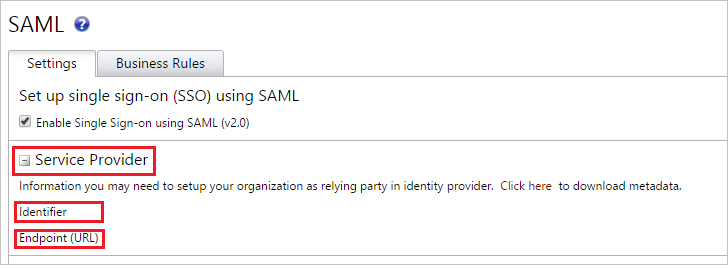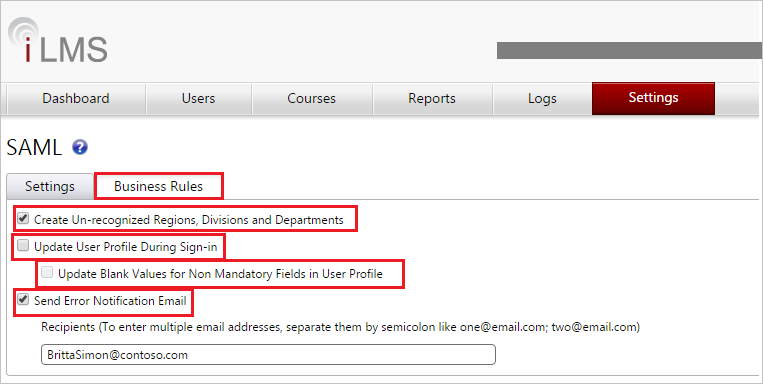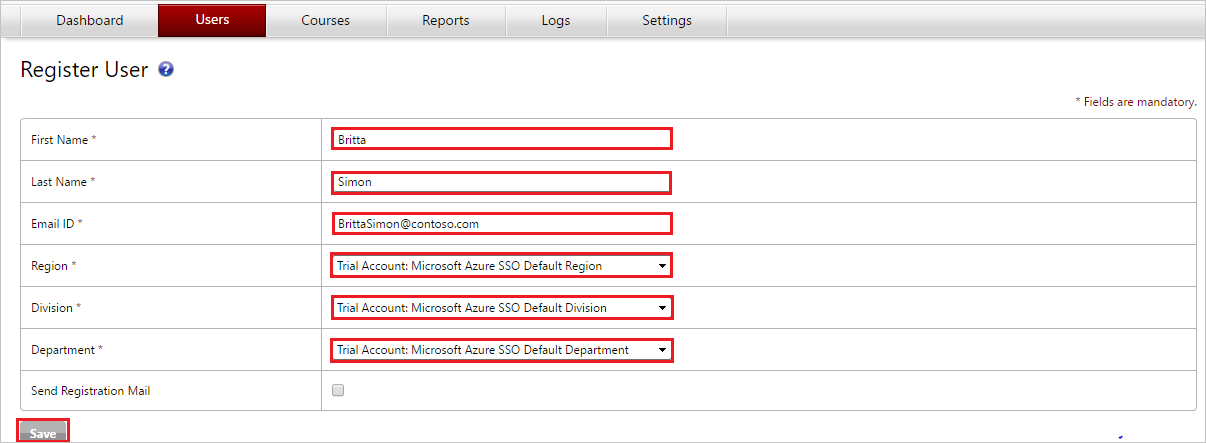Tutorial: Integrate iLMS with Microsoft Entra ID
In this tutorial, you'll learn how to integrate iLMS with Microsoft Entra ID. When you integrate iLMS with Microsoft Entra ID, you can:
- Control in Microsoft Entra ID who has access to iLMS.
- Enable your users to be automatically signed-in to iLMS with their Microsoft Entra accounts.
- Manage your accounts in one central location.
Prerequisites
To get started, you need the following items:
- A Microsoft Entra subscription. If you don't have a subscription, you can get a free account.
- iLMS single sign-on (SSO) enabled subscription.
Scenario description
In this tutorial, you configure and test Microsoft Entra SSO in a test environment.
- iLMS supports SP and IDP initiated SSO.
Note
Identifier of this application is a fixed string value so only one instance can be configured in one tenant.
Add iLMS from the gallery
To configure the integration of iLMS into Microsoft Entra ID, you need to add iLMS from the gallery to your list of managed SaaS apps.
- Sign in to the Microsoft Entra admin center as at least a Cloud Application Administrator.
- Browse to Identity > Applications > Enterprise applications > New application.
- In the Add from the gallery section, type iLMS in the search box.
- Select iLMS from results panel and then add the app. Wait a few seconds while the app is added to your tenant.
Alternatively, you can also use the Enterprise App Configuration Wizard. In this wizard, you can add an application to your tenant, add users/groups to the app, assign roles, as well as walk through the SSO configuration as well. Learn more about Microsoft 365 wizards.
Configure and test Microsoft Entra SSO for iLMS
Configure and test Microsoft Entra SSO with iLMS using a test user called B.Simon. For SSO to work, you need to establish a link relationship between a Microsoft Entra user and the related user in iLMS.
To configure and test Microsoft Entra SSO with iLMS, perform the following steps:
- Configure Microsoft Entra SSO - to enable your users to use this feature.
- Create a Microsoft Entra test user - to test Microsoft Entra single sign-on with B.Simon.
- Assign the Microsoft Entra test user - to enable B.Simon to use Microsoft Entra single sign-on.
- Configure iLMS SSO - to configure the single sign-on settings on application side.
- Create iLMS test user - to have a counterpart of B.Simon in iLMS that is linked to the Microsoft Entra representation of user.
- Test SSO - to verify whether the configuration works.
Configure Microsoft Entra SSO
Follow these steps to enable Microsoft Entra SSO.
Sign in to the Microsoft Entra admin center as at least a Cloud Application Administrator.
Browse to Identity > Applications > Enterprise applications > iLMS application integration page, find the Manage section and select Single sign-on.
On the Select a Single sign-on method page, select SAML.
On the Set up Single Sign-On with SAML page, click the pencil icon for Basic SAML Configuration to edit the settings.

On the Basic SAML Configuration page, if you wish to configure the application in IDP initiated mode, perform the following steps:
a. In the Identifier text box, paste the Identifier value you copy from Service Provider section of SAML settings in iLMS admin portal.
b. In the Reply URL text box, paste the Endpoint (URL) value you copy from Service Provider section of SAML settings in iLMS admin portal having the following pattern:
https://www.inspiredlms.com/Login/<INSTANCE_NAME>/consumer.aspx.Click Set additional URLs and perform the following step if you wish to configure the application in SP initiated mode:
In the Sign-on URL text box, paste the Endpoint (URL) value you copy from Service Provider section of SAML settings in iLMS admin portal as
https://www.inspiredlms.com/Login/<INSTANCE_NAME>/consumer.aspx.To enable JIT provisioning, your iLMS application expects the SAML assertions in a specific format, which requires you to add custom attribute mappings to your SAML token attributes configuration. The following screenshot shows the list of default attributes. Click Edit icon to open User Attributes dialog.
Note
You have to enable Create Un-recognized User Account in iLMS to map these attributes. Follow the instructions here to get an idea on the attributes configuration.
In addition to above, iLMS application expects few more attributes to be passed back in SAML response. In the User Claims section on the User Attributes dialog, perform the following steps to add SAML token attribute as shown in the below table:
Name Source Attribute division user.department region user.state department user.jobtitle a. Click Add new claim to open the Manage user claims dialog.
b. In the Name textbox, type the attribute name shown for that row.
c. Leave the Namespace blank.
d. Select Source as Attribute.
e. From the Source attribute list, type the attribute value shown for that row.
f. Click Ok
g. Click Save.
On the Set up Single Sign-On with SAML page, in the SAML Signing Certificate section, click Download to download the Federation Metadata XML from the given options as per your requirement and save it on your computer.

On the Set up iLMS section, copy the appropriate URL(s) as per your requirement.

Create a Microsoft Entra test user
In this section, you'll create a test user called Britta Simon.
- Sign in to the Microsoft Entra admin center as at least a User Administrator.
- Browse to Identity > Users > All users.
- Select New user > Create new user, at the top of the screen.
- In the User properties, follow these steps:
- In the Display name field, enter
B.Simon. - In the User principal name field, enter the username@companydomain.extension. For example,
B.Simon@contoso.com. - Select the Show password check box, and then write down the value that's displayed in the Password box.
- Select Review + create.
- In the Display name field, enter
- Select Create.
Assign the Microsoft Entra test user
In this section, you'll enable B.Simon to use single sign-on by granting access to iLMS.
- Sign in to the Microsoft Entra admin center as at least a Cloud Application Administrator.
- Browse to Identity > Applications > Enterprise applications > iLMS.
- In the app's overview page, select Users and groups.
- Select Add user/group, then select Users and groups in the Add Assignment dialog.
- In the Users and groups dialog, select B.Simon from the Users list, then click the Select button at the bottom of the screen.
- If you are expecting a role to be assigned to the users, you can select it from the Select a role dropdown. If no role has been set up for this app, you see "Default Access" role selected.
- In the Add Assignment dialog, click the Assign button.
Configure iLMS SSO
In a different web browser window, sign in to your iLMS admin portal as an administrator.
Click SSO:SAML under Settings tab to open SAML settings and perform the following steps:

Expand the Service Provider section and copy the Identifier and Endpoint (URL) value.

Under Identity Provider section, click Import Metadata.
Select the Federation Metadata file downloaded from the SAML Signing Certificate section.

If you want to enable JIT provisioning to create iLMS accounts for un-recognize users, follow below steps:
a. Check Create Un-recognized User Account.

b. Map the attributes in Microsoft Entra ID with the attributes in iLMS. In the attribute column, specify the attributes name or the default value.
c. Go to Business Rules tab and perform the following steps:

d. Check Create Un-recognized Regions, Divisions and Departments to create Regions, Divisions, and Departments that do not already exist at the time of Single Sign-on.
e. Check Update User Profile During Sign-in to specify whether the user’s profile is updated with each Single Sign-on.
f. If the Update Blank Values for Non Mandatory Fields in User Profile option is checked, optional profile fields that are blank upon sign in will also cause the user’s iLMS profile to contain blank values for those fields.
g. Check Send Error Notification Email and enter the email of the user where you want to receive the error notification email.
Click Save button to save the settings.

Create iLMS test user
Application supports Just in time user provisioning and after authentication users are created in the application automatically. JIT will work, if you have clicked the Create Un-recognized User Account checkbox during SAML configuration setting at iLMS admin portal.
If you need to create a user manually, then follow below steps:
Sign in to your iLMS company site as an administrator.
Click Register User under Users tab to open Register User page.

On the Register User page, perform the following steps.

a. In the First Name textbox, type the first name like Britta.
b. In the Last Name textbox, type the last name like Simon.
c. In the Email ID textbox, type the email address of the user like BrittaSimon@contoso.com.
d. In the Region dropdown, select the value for region.
e. In the Division dropdown, select the value for division.
f. In the Department dropdown, select the value for department.
g. Click Save.
Note
You can send registration mail to user by selecting Send Registration Mail checkbox.
Test SSO
In this section, you test your Microsoft Entra single sign-on configuration with following options.
SP initiated:
Click on Test this application, this will redirect to iLMS Sign on URL where you can initiate the login flow.
Go to iLMS Sign-on URL directly and initiate the login flow from there.
IDP initiated:
- Click on Test this application, and you should be automatically signed in to the iLMS for which you set up the SSO.
You can also use Microsoft My Apps to test the application in any mode. When you click the iLMS tile in the My Apps, if configured in SP mode you would be redirected to the application sign on page for initiating the login flow and if configured in IDP mode, you should be automatically signed in to the iLMS for which you set up the SSO. For more information about the My Apps, see Introduction to the My Apps.
Next steps
Once you configure iLMS you can enforce session control, which protects exfiltration and infiltration of your organization’s sensitive data in real time. Session control extends from Conditional Access. Learn how to enforce session control with Microsoft Defender for Cloud Apps.
Feedback
Coming soon: Throughout 2024 we will be phasing out GitHub Issues as the feedback mechanism for content and replacing it with a new feedback system. For more information see: https://aka.ms/ContentUserFeedback.
Submit and view feedback for